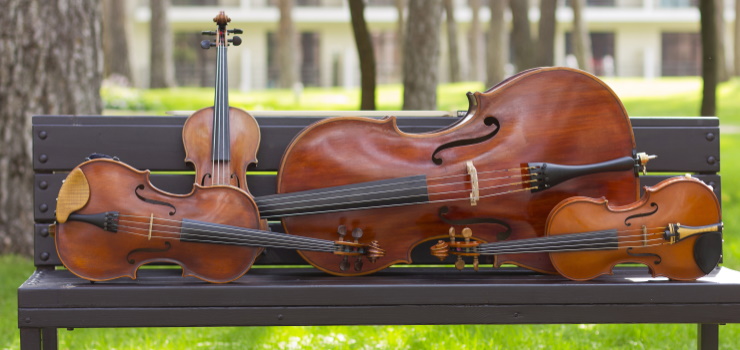There are 8 different sizes of violins: 1/16, 1/10, 1/8, 1/4, 1/2, 3/4, 7/8, and full-sized. After careful speculation, you might have decided to choose the violin for yourself or your child. Your first order of business is to buy your child an accurately-sized instrument. There are numerous choices for you when it comes to violin sizes. Some are catered to fit the small hands of children while others are meant to be played by adult musicians.
Thus, it is important that you know about the different sizes and how to choose the best one for your child. An incorrect size can often lead to harrowing problems which may cause bumps in your child’s musical career.
Contents
A violin is a stringed instrument that is an accumulation of other older stringed instruments such as the rebec, vielle, and the lira. Its construction often includes the same kind of wood that a piano does. The basic anatomy includes a fingerboard, pegs, neck, tail, and ribs.
If you’re a beginner, then you might find it easy to play the violin. The varying sizes of the violin allow you to pick out one that rests perfectly between your neck and arm. Furthermore, they make it easier for younger players to pick one out according to their arm sizes.

Violins are popular among children and adults alike. Thus, it is important that folks of all ages and sizes can find their perfect fit without any hassles. This is why manufacturers make violins in varying sizes so even a small child can find a model that he/she can play and hold comfortably.
Think about it: a small child with a big violin? Seems like a gimmick! For a child, playing a heavy or bulky violin can result in sore arms and it might even hurt their neck or back. A bigger violin also has a larger fingerboard which places some notes out of his/her reach.
This can be uncomfortable and might discourage your child from playing the instrument. In addition, if the violin is too large, it won’t sit properly between his/her neck and shoulder. This can result in mediocre playing.
There are 8 different sizes of violins, which are:
1/16: This is the smallest official size available in the market. It is perfect for young kids who are just starting out on their musical journey. It is best suited for kids between 3 to 5 years old who have an arm length of about 14 to 15.375 inches.
1/10: There is only a slight difference between the previous version and this one. It is also for kids between the ages of 3 to 5 years with an arm length ranging from 15.375 to 17 inches.
1/8: Another variant meant for children, the 1/8 size is for those 4 - 6-year-old kids who have an arm length of about 17.1 to 17.5 inches. This variant is meant to be played with a 19.25-inch long bow.
1/4: The ¼ is best suited to beginners and the total arm length may be anywhere from 17.6 to 20 inches.
1/2: The half-sized violin is for children who are 6 to 10 years old. This is the perfect transition model for kids who want to move on to a bigger-sized violin. The corresponding arm length is from 20 to 22 inches.
3/4: This is meant for older kids who have an arm measurement of 22 to 23.5 inches. It includes a higher quality material construction and is perfect when played with a 27-inch bow.
7/8: You might not find many 7/8 sized violins as there is not a huge difference between this size and the full-size version. It usually measures about 22.5 – 23 inches in length. What’s unique about this size is that adults with smaller hands and arms can play this more conveniently than the full-size version.
Full-Size Violin (4/4): The full-size violin is for older kids and adults. It tends to be the most popular size in the market. Moreover, it has an arm length greater than 23.5 inches. Of course, it might be heavier than other models, but as an adult, you’ll be able to handle it easily.
The best way to find the perfect violin size for your child is to ensure the correct measurement of the arm length. Here’s how to measure your child’s arm length:
|
Age |
Minimum Arm Length |
Corresponding Violin Size |
|
3-4 |
15 inches |
1/16 |
|
4-5 |
16 inches |
1/10 |
|
5-6 |
16 inches |
1/10 |
|
6-7 |
18 inches |
1/8 |
|
7-8 |
18 inches |
1/8 |
|
8-9 |
20 inches |
1/4 |
|
9-10 |
20 inches |
1/4 |
|
10-11 |
22 inches |
1/2 |
|
11-12 |
22 inches |
1/2 |
|
12-13 |
23 inches |
3/4 |
|
13+ |
23 inches+ |
4/4 |
With so many different sized violins in the market, it is almost certain that you will find your child’s match. This also means that your child may need to transition to a bigger instrument as he or she grows.
Copyright © 2024 MSpot. All rights reserved. Privacy Policy & Cookie Disclaimer.
mspot.com is a participant in the Amazon Services LLC Associates Program, an affiliate advertising program designed to provide a means for sites to earn advertising fees by advertising and linking to Amazon.com. As an Amazon Associate, we earn from qualifying purchases.